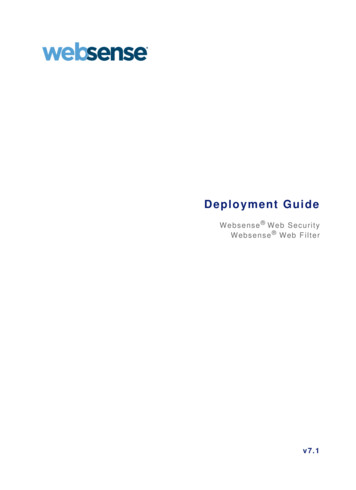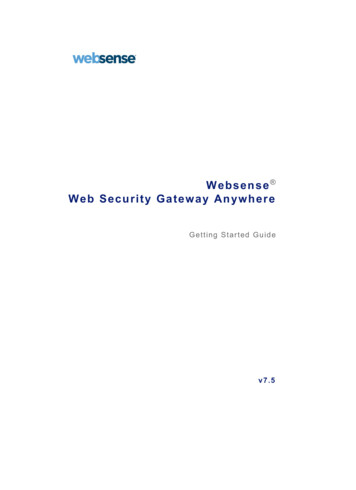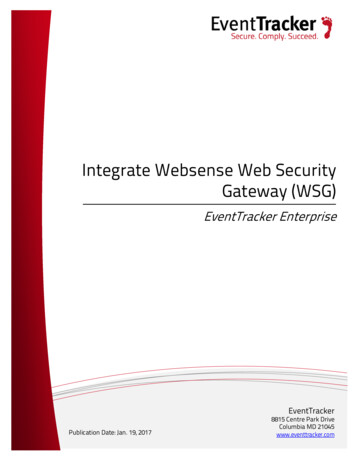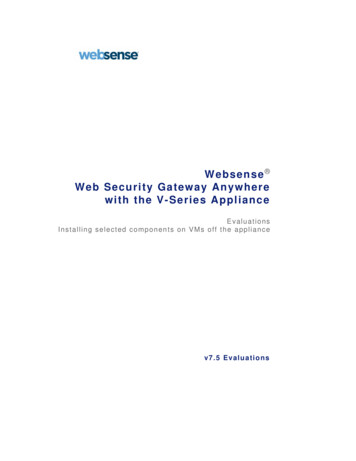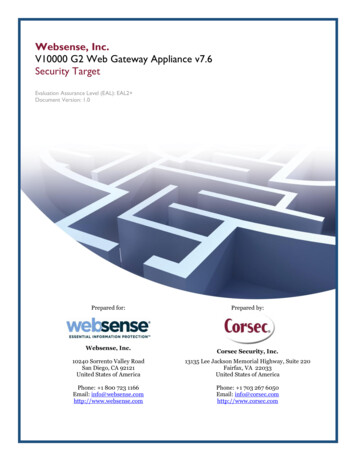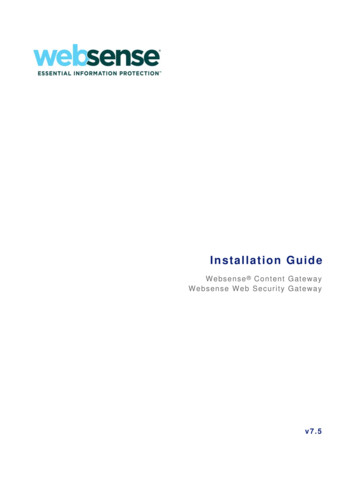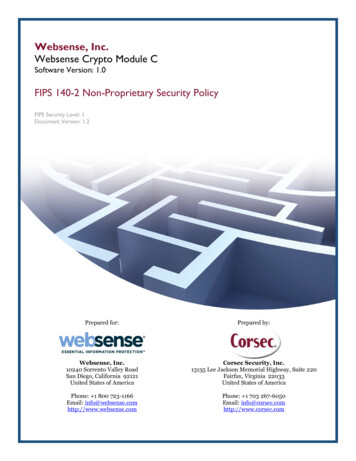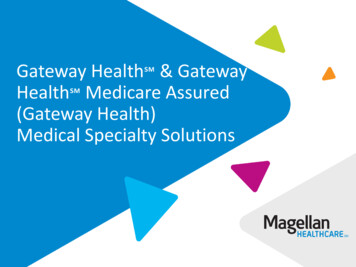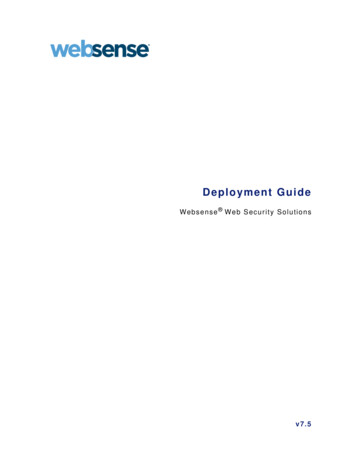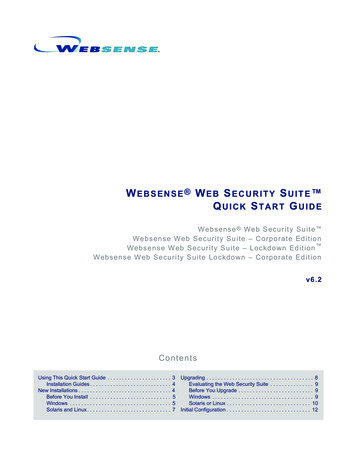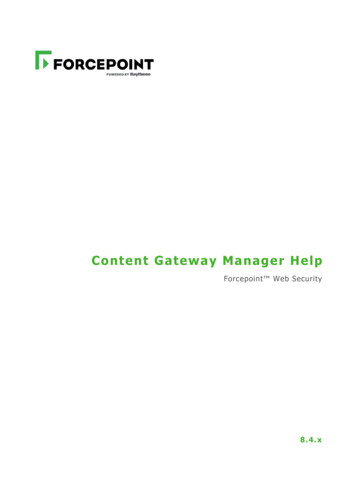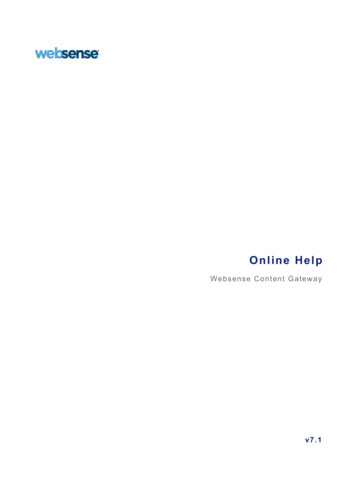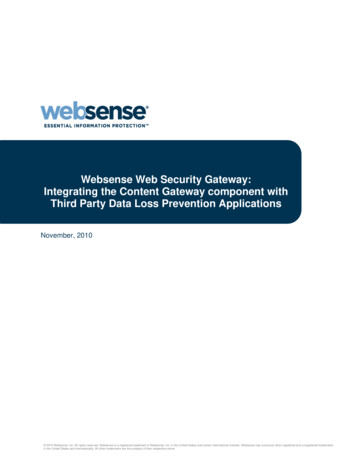
Transcription
Websense Web Security Gateway:Integrating the Content Gateway component withThird Party Data Loss Prevention ApplicationsNovember, 2010 2010 Websense, Inc. All rights reserved. Websense is a registered trademark of Websense, Inc. in the United States and certain international markets. Websense has numerous other registered and unregistered trademarksin the United States and internationally. All other trademarks are the property of their respective owner.
ContentsSolution Summary .3Solution Diagram .3Introduction .4How it works: . 4Before You Begin . 4Configuring the Websense Content Gateway ICAP Client . 5Configuring the ICAP Server .72
Solution SummaryWebsense Web Security Gateway provides real‐time content scanning and Web site classification toprotect network computers from malicious Web content while controlling employee access to dynamic,user‐generated Web 2.0 content.Web content has evolved from a static information source to a sophisticated platform for 2‐waycommunications, which can be a valuable productivity tool when adequately secured. The dilemma foradministrators is how much access to allow. Web 2.0 sites rely primarily on HTTP/HTTPS protocols, whichcannot be blocked without halting all Internet traffic. Malicious content can use this means of entry into acompany network.Websense Web Security Gateway contains a high‐performance Web proxy – Websense ContentGateway, that supports deep content inspection.The Websense Content Gateway module offers: Automatic categorization of dynamic Web 2.0 sites Automatic categorization of new, unclassified sites HTTPS content inspection Enterprise proxy caching capabilitiesWebsense Content Gateway supports the ICAP v1 protocol for integration with third party data lossprevention (DLP) applications, such as Symantec Data Loss Prevention (formerly Vontu Data LossPrevention), and RSA Data Loss Prevention. Data loss prevention applications deliver multi‐protocolmonitoring and blocking of sensitive data leaving the network. DLP is available in various configurations,one of which utilizes a HTTP/HTTPS/FTP proxy with ICAP client such as the Websense Content Gatewayfor monitoring and blocking of sensitive data.This document provides instructions on configuring Websense Content Gateway as an ICAP client fornon‐Websense DLP products acting as the ICAP server.Solution Diagram3
IntroductionWebsense Content Gateway supports integration with Symantec Data Loss Prevention and RSA Data LossPrevention through the ICAP v1 (Internet Content Adaptation Protocol) interface.Symantec and RSA sites can apply their DLP tools to the flow of traffic that transits Content Gateway onits way to the Internet. The integration facilitates off‐loading of HTTP POST, HTTPS POST (if SSL Manageris enabled), and FTP PUT to a designated DLP server for content analysis and policy enforcement. In thisconfiguration, Content Gateway acts as an ICAP client communicating with the DLP application, whichacts as an ICAP server.How it works:1. Content Gateway intercepts outbound content and provides that content to the DLP applicationvia ICAP v1.2. The DLP application determines if the Web posting or FTP upload is allowed or blocked. The determination is based on policy. The disposition is communicated to Content Gateway. The DLP application logs the transaction.3. Content Gateway acts on the determination.a. If the content is blocked, it is not transmitted to the remote host and the DLP applicationreturns a block page to the sender.*b. If the content is allowed, it is forwarded to its destination.Transaction details are logged by the DLP application, per its configuration.*Block page handlingWhen a request is blocked and the DLP server sends a block page in response: Content Gateway forwards the block page to the sender in a 403 Forbidden message. The block page must be larger than 512 bytes or some user agents (e.g., Internet Explorer) willsubstitute a generic error message.Before You BeginThis section provides instructions for integrating with the third party DLP application. This document isnot intended to suggest optimum installations or configurations.It is assumed that the reader has working knowledge of all products involved, and the ability to performthe tasks outlined in this section. Administrators should have access to the product documentation for allproducts in order to install the required components.All vendor products and components must be installed and working prior to the integration. Perform thenecessary tests to confirm that this is true before proceeding.4
Configuring the Websense Content Gateway ICAP ClientNote: This document assumes that the administrator has deployed andconfigured Websense Content Gateway to proxy HTTP(S) and/or FTP trafficas outlined in the Deploying with Websense Content Gateway Guide.Ensure that all proxy traffic is working properly before beginning any of theprocedures listed below.The Content Gateway ICAP v1 interface supports Websense Data Security Suite, Symantec Data LossPrevention, RSA Data Loss Prevention, and other applications that act as ICAP servers.To configure integration with ICAP, log on to Content Gateway Manager and go to the Configure My Proxy Basic General page.1. In the Networking section of the Features table, select Data Security On, and select ICAP.2. Click Apply, and then click Restart (top of page).5
3. Navigate to Configure Networking ICAP General.6
4. In the ICAP Service URI field, enter the Uniform Resource Identifier (URI) for the ICAP server.A URI is similar to a URL, but the URI ends with a directory, rather than a page. Obtain the identifierfrom your DLP application administrator. Enter the URI in the following format:icap://hostname:port/pathFor hostname, enter the IP address or hostname of the DLP server.The default ICAP port is 1344.Path is the path of the ICAP service on the host machine.For example:icap://ICAP machine:1344/REQMODYou do not need to specify the port if you are using the default ICAP port 1344.5. Under Analyze HTTPS Content, indicate if decrypted traffic should be sent to the DLP server foranalysis or sent directly to the destination. You must be running SSL Manager to send HTTPS traffic tothe DLP server.6. Under Analyze FTP Uploads, select whether to send FTP upload requests to the DLP server foranalysis. The FTP proxy feature must be enabled to send FTP traffic to the DLP server.7. Under Action for Communication Errors, select whether to permit traffic or send a block page ifContent Gateway encounters an error while communicating with the DLP server.8. Under Action for Large Files, select whether to permit traffic or send a block page if a file larger thanthe size limit specified by the DLP server is sent.9. Click Apply.NOTE: If you change the URI, you must restart Content Gateway. Other changes do not require a restart.Configuring the ICAP ServerConfigure the Symantec or RSA DLP server for ICAP per the vendor’s product documentation.7
Websense Web Security Gateway provides real‐time content scanning and Web site classification to protect network computers from malicious Web content while controlling employee access to dynamic,
